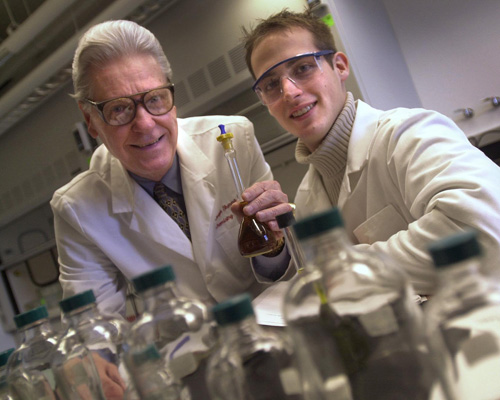Trustee Scholar Jacob Sechrist ’04 (York, Pa.), a biochemistry major, spent the January interim session investigating a pigment that may help improve vision.
As an EXCEL Scholar with Joseph Sherma, professor emeritus of chemistry, and Bernard Fried, professor emeritus of biology, Sechrist analyzed vitamins and other pills containing lutein, comparing his measurements against the labels.
Sechrist used a laboratory method called High Performance Thin Layer Chromatography to study lutein, which he says is a xanthophyll pigment in plants and animals. Found in the human eye, it is thought by some to improve vision and is taken to battle macular degeneration.
“Many times a lutein ester, rather than pure lutein, is used in vitamins, so this is one point I’m interested in,” says Sechrist.
In the High Performance Thin Layer Chromatography process, Sechrist prepares a standard lutein solution, then spots the solution, in different volumes and known weights, on a Merck reverse phase C18 silica gel plate using a linomat machine. Next the student develops the plate in a mobile phase that lets the spots “move up” the plate and redeposit a distance from the application point. He allows the plate to dry and analyzes it using a scanning densitometer.
“I’m able to obtain a calibration curve from these standard sorts and to spot the lutein samples of unknown concentration against my lutein standards,” says Sechrist. “According to the area of the spot, the densitometer is able to place the sample along my calibration curve and tell me the corresponding weight of the sample. Then I can figure out percent recovery of the sample depending on the label value of lutein present within the original pill or vitamin.”
Sherma says Sechrist made “tremendous progress” in three weeks on the work begun by another student, and the results of both will likely be published.
“He’s only a sophomore and I’m sure he learned a lot,” says Sherma of Sechrist. Specifically, the professor says Sechrist learned sample preparation and how to attack a scientific problem.
Sechrist says he enjoyed the interim session, as he could devote all of his time to the project and problem solving.
“I believe the EXCEL program, my project and projects like mine, give undergraduates an incredible chance to involve themselves with research and gain understanding of real-world problems and difficulties,” says Sechrist. “It gives students the upper hand against others who do not have the same opportunities. This is one thing that makes Lafayette a truly great academic institution.”
A graduate of Central York High School, Sechrist is a member of the Crew Club.

A National Leader in Undergraduate Research. Jacob Sechrist ’04 coauthored an article in Acta Chromatographica with Joseph Sherma, professor emeritus of chemistry.
